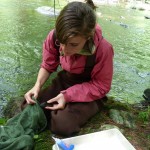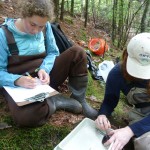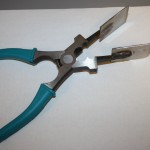The Trouble with Mussels Is…

The freshwater pearl mussel has a unique life cycle that includes female mussels ingesting sperm from the surrounding water to fertilize their eggs. Once the eggs are fertilized the female is considered gravid, or pregnant. The fertilized eggs (glochidia) are then held on the gills for around 30 days to develop before they are released into the water. Part of my study of the freshwater mussel Margaritifera margartifera involves first collecting and tagging 50 mussels and second checking and tracking their gravidity.

The first part of this process went quite smoothly. I collected 50 individuals from a site in the East Branch Swift River in Petersham, MA with the help of Hannah Reich and Nick Pagan. We then created a mussel tagging assembly line, and everyone had their prescribed jobs. I dried a portion of the mussel shell, added a small drop of super glue to the shell, placed a small, yellow, plastic tag on the glue and passed the mussel to Nick. Nick then held down the tag on the shell for around a minute with tweezers and positioned the mussel for a photograph. Finally, Hannah photographed the mussel with the tag so I could measure each mussel from the photograph and wrote down the tag number on a data sheet.

The second part of this process proved to be more challenging. In order to determine if a mussel is gravid you have to open the mussel and examine the gills for a creamy colored mass. Now I thought that a mussel no longer than your middle finger would be easy to open and study. However after my first encounter a year ago trying in vain to pry open a mussel with my fingers, I realized that these organisms were surprisingly strong. While I was in Germany working with Professor Jürgen Geist and his team of students and technicians I learned that they developed a special tool to combat the unbelievable strength of these mussels. The tool was reverse pliers (meaning that you had to squeeze the pliers to close them) with two extremely thin stainless steel plates welded to the plier tips. These stainless steel plates had to be thin so that they could slide between the two halves of the mussel shell and pry it open. The first time I went to the stream in Massachusetts to check gravidity; however, I only brought normal pliers, assuming for some reason that these could open my tagged mussels. I quickly learned that I needed to create the magical tool I saw in Germany because I could not open a single mussel with normal pliers. After a short meeting with Joel Norton, Clark University’s machinist, he was able to create the pliers, and I am now opening and examining the mussels with easy. Sadly none of the mussel I have seen are gravid but I will just have to wait and see!